|
|
By Jo Nova
A new paper (like so many before it) shows that the sea started warming half a century before the first coal fired power plant was ever built, demonstrating yet again, the skeptics are right, and CO2 is irrelevant. Despite that, the world’s supposedly top science journal lauded it in excitement because it showed the world had warmed “more than we thought”, and somehow, in their brains, ipso delerium, all warming was caused by man-made CO2 even if it occurred when there were no flights, no cars, and no electricity.
Life in 1820 was the ultimate “Net Zero” world: literally every flight was grounded and all petrol stations were closed for 80 years yet the world warmed.
Absurdly, evangelistic headlines decreed the world was “hotter than we thought”, had breached 1.5C earlier than we thought and three hundred year old sea sponges were telling us to hurry up and install solar panels. The point that the geniuses who are 99% certain didn’t know how hot the 1800s were until last week isn’t exactly inspiring. But the political activists at Nature felt that breaching the Paris Agreement (before it was even made) was big news and said so in their first paragraph. All the major nations are failing to meet their Paris targets anyway, and if the targets were expired before they were even set, that only makes the UN look stupid. And to top that off, somehow a thousand thermometers, ship buckets and tree rings have just been superseded by some old Puerto Rican sponges.
As it happens the team at Nature also seem to have forgotten they already announced in 2016 that global warming started 180 years ago. Perhaps they don’t read their own papers? (That was Abram et al).
Really, this new paper makes a great study in just how bad current science communication is — every single person in the chain of nonsense failed to see the bleeding obvious. The academics, the journal, the press release team and the “media” all missed the most important message the corals were shouting from the bottom of the ocean. Humans don’t control the climate.
By the time that official temperature records began, global temperatures had already risen by half a degree.
The planet has already passed 1.5 °C of warming, according to a new measuring technique that goes back further in time than current methods. At the 2015 Paris Climate Accords, nations agreed not to exceed 1.5 °C, a guardrail of climate change.
“We have an alternate record of global warming,” says coral-reef geochemist Malcolm McCulloch at the University of West Australia Oceans Institute in Crawley, who is lead author of the study. “It looks like temperatures were underestimated by about half a degree.”
Even though the paper says the warming started in 1860, the data shows it started earlier, more like 1820. Apparently the Sr/Ca ratio is a good proxy for the temperature they say.
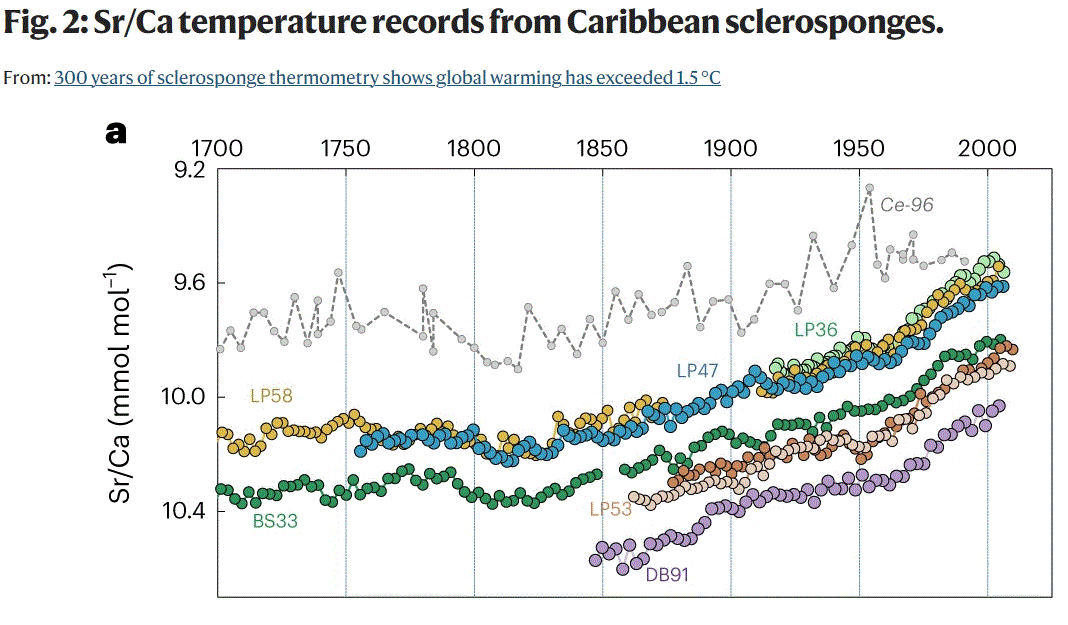
But 90% of human emissions have been emitted since World War II.
…
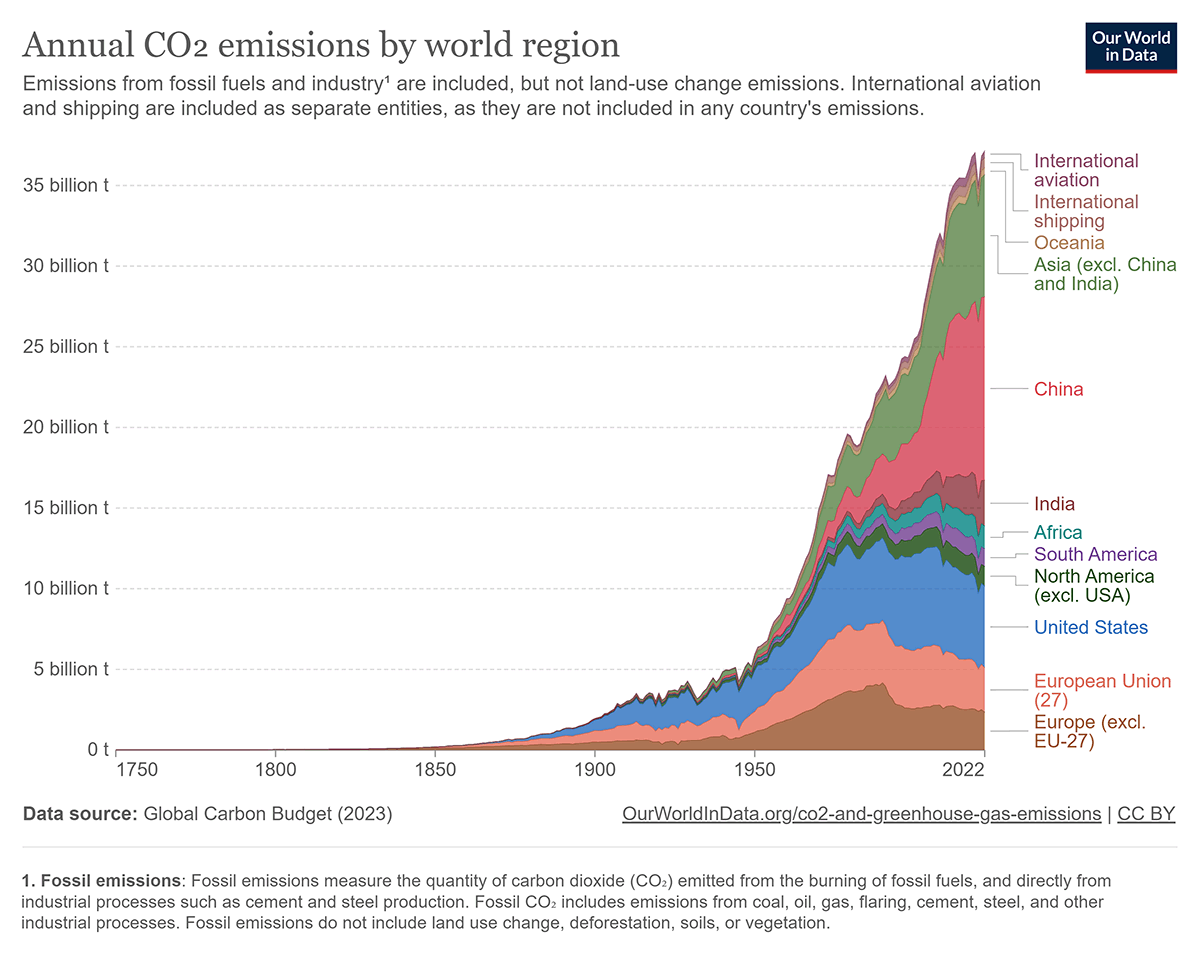
Source: OWID
It does however look similar to graphs of rising sea levels that we’ve known about for years.
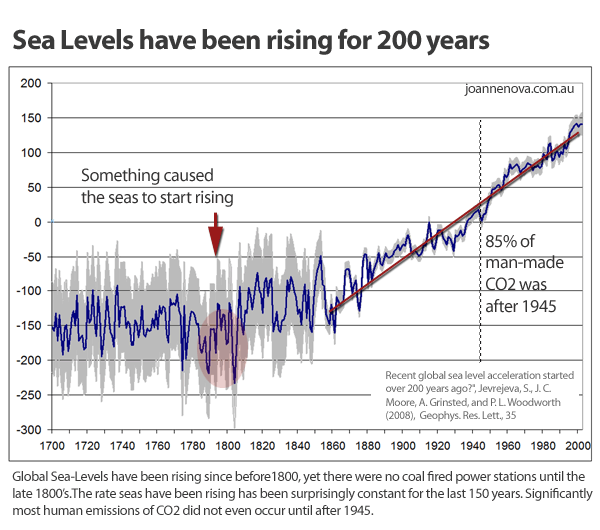
Jevrejeva et al 2008
And a lot like graphs of 120 proxies from the Northern Hemisphere:
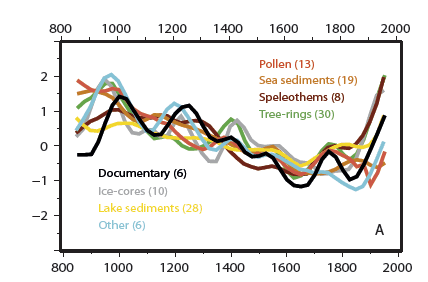
Ljungqvist et al.
And other proxies from China
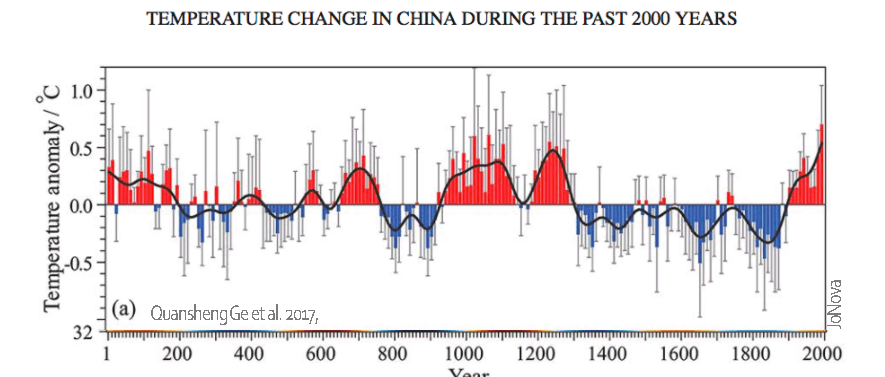 …. Absurdities of the modern era — that newspapers all over the world tell us CO2 is even more dangerous than we thought because of some sponges in the Caribbean.
REFERENCES
Keep reading →
9.8 out of 10 based on 80 ratings
9.8 out of 10 based on 12 ratings
9.4 out of 10 based on 9 ratings
 Paul Englher | ABC News Paul Englher | ABC News
By Jo Nova
Just how wise is it to have a grid dependent on all this fragile infrastructure?
Nature seems to be telling us something about adding another 10,000 kilometers of vulnerable transmission lines.
Yesterday six high voltage transmission lines collapsed in Victoria leaving half a million people without electricity for hours. But only a few weeks ago five towers collapsed in Western Australia putting 30,000 in the dark. And out in Kalgoorlie, when the gas backup plants failed, thousands of people went for days without power in 40 degree heat. Some people were unable to call triple zero, freezers full of food were spoilt and nearly everything left to buy had to be paid for in cash.
In Victoria the towers fell at 1:10pm during a storm. Their loss triggered the shut down of 4 large coal power units at Loy B Yang taking out 2 GW of generation. It took three hours to get one turbine back on line, and eight hours to restore the second. Everyone is talking about “the coal fired outage” but about half the wind power running at the time was also lost, and over the next hour, more than half the grid scale solar power also disappeared.
It was a shock to the system for a state with nearly 7 million people:

Graph from Anero.id Enery (Feb 13)
The sudden simultaneous drops for wind power and coal power suggests they were both affected by the transmission line failures. Brown coal generation fell almost instantly from 4GW to 2GW, but wind power in the state fell from 1.8GW to 1GW sharply.

Graph from Anero.id Enery (Feb 13)
Solar and wind power just made the storm damage worse:
The renewable cheer squad is calling for “a faster transition” to somehow solve these blackouts but both solar and wind power need thousands of miles of the very same collapsible transmission lines, putting the grid at even more risk of sudden breaks.
Indeed wind power fell right when we needed it. We can’t confirm yet how much of that was due to the towers collapsing, or whether it was because plants were shutting off in turbulent conditions.
Grid scale solar certainly didn’t save the day even though it was the middle of the day. Perhaps the solar plants were cut off, or perhaps the clouds rolled over? Solar “farm” production was reduced from 500MW to 200MW through most of the afternoon. And while rooftop solar suffered smaller losses, by 2pm it lost about 1 GW of generation too. About the nicest thing we can say about solar power is that it won’t destabilize the grid if storms arrive at night.
The things that did save the day were gas and hydro power (see below), but if Hazelwood coal power was still running, it would have helped too. Luckily, there is no drought on the East Coast at the moment. In a normal El Nino year, the hydro might not have been there…
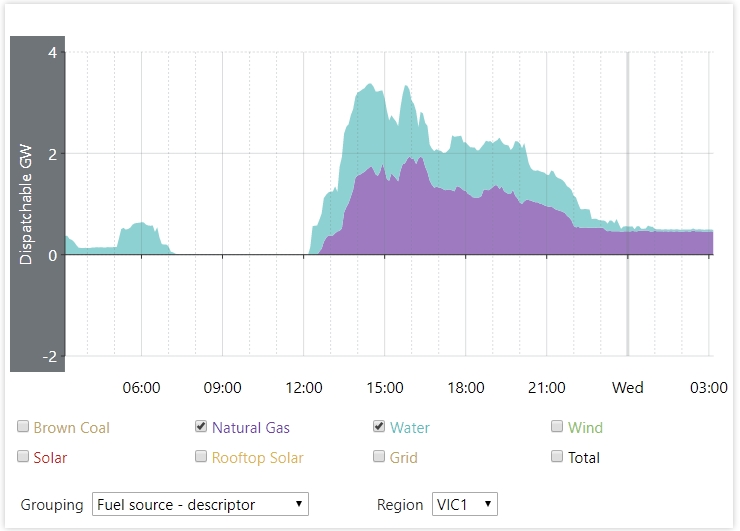
Graph from Anero.id Enery
The Victorian Energy Minister blames the weather and doesn’t seem to realize some forms of generation need a thousand more miles of power lines:
But Victorian Energy Minister Lily D’Ambrosio said that if “catastrophic extreme weather” physically took out power lines, “then no matter what you do in terms of electricity generation or other technologies, that will cause outages”.
But if all of the state ran on coal fired power or gas, less of the state would have blacked out.
Grids with lots of transmission lines are vulnerable grids
The Guardian, masters of misinformation, told us that the coal fired plants were affected by the storms, just in case you thought they might be stronger than flimsy windmills and giant sheets of glass panels.
 The Guardian didn’t mention the 2GW drop in wind power and solar output. They happen every day of course… The Guardian didn’t mention the 2GW drop in wind power and solar output. They happen every day of course…
Further information is available from WattClarity — like grid inertia, and the frequency volatility.
9.8 out of 10 based on 97 ratings

By Jo Nova
The global carbon market in sacred certificates-to-stop-storms now “worth” nearly one trillion dollars
Remember this number next time someone tells you fossil fuels are stopping “climate action”.
The whole trillion dollar carbon market is a vested interest. It is a fake market entirely created on government whimsy. The whole absurd point of it is supposedly to slow tornadoes or floods in 2100, and reduce beach-weather in Europe. Because who likes the beach?
LONDON, Feb 7 (Reuters) – The value of traded global markets for carbon dioxide (CO2) permits reached a record 850 billion euros ($909 billion) last year, analysts at Refinitiv said on Tuesday. Around 12.5 billion tonnes of carbon permits changed hands in the world’s emissions markets – 20% less than the previous year – but the value of the markets rose by 14% as prices for permits were much higher.
In a carbon market, certain favoured groups can say they produced less carbon dioxide this year than they otherwise might have. They get to sell their anointed pieces of paper to other less favoured people who have to buy credits because the government says they must. At any point in this game, industries can get exemptions added or allowances boosted. So if the bribes or post-political-life jobs on offer are good enough, the right people can arrange to divert the river of money toward their own accounts. And the insiders can buy or sell the shares as the government policy changes. It creates a vast economy of busy work and a big pile of money.
The great thing about this political and fundraising tool (for criminals) is that almost anything can be “flexed”. The potential for loopholes is infinite because this is not a free market, just the illusion of one. For starters there’s no product anyone cares about at the end of the chain –there’s no cargo ship of diamonds that someone will miss. Corruption can run riot, and who would know?
The carbon market is not really a carbon market at all — the largest producers of CO2 are not even in the game. The Pacific Ocean can’t pay, the phytoplankton can’t be taxed and the northern boreal forests will get plain away with it unless a friend of a friend happens to own a nice plot that can be rebadged as a carbon farm. So politicians are sitting on a gold mine of opportunity. Most carbon in the world doesn’t count, and they get to be kingmakers to decide what does. What’s an act of God? — ask the Minister.
If, hypothetically, our elected representatives were less than angelic, they could tweak the terms and conditions to their donors’ hearts content. The ruling party in charge decides whether your saltbush credits are accepted, or whether your organic goats cheese gets an exception. Is nuclear power “carbon neutral”? Fifty years laters, the EU still can’t decide.
If an election is coming up, the ruling party can roll out some more credits and reduce the “cost of living” at least until after the votes are in.

The Game of Carbon Leeches works because the money is stolen quietly from the people. Thousands upon millions of shoemakers, mechanics, bakers and cleaners pay higher prices for peas, beans and widgets because somewhere down the supply chain someone or several of the people involved had to buy some fairy carbon credits. Their fake costs are added to our real bills. The money is siphoned invisibly from the masses and given to the special classes. Did you get lucky?
The carbon market is gradual creeping communism, but even the Soviets didn’t tax the proletariat to give their grandchildren better weather.
Elephant artwork by Jo Nova adapted from Wikimedia photo: Hansm
9.9 out of 10 based on 116 ratings
8.6 out of 10 based on 20 ratings
8.4 out of 10 based on 34 ratings
9.1 out of 10 based on 27 ratings
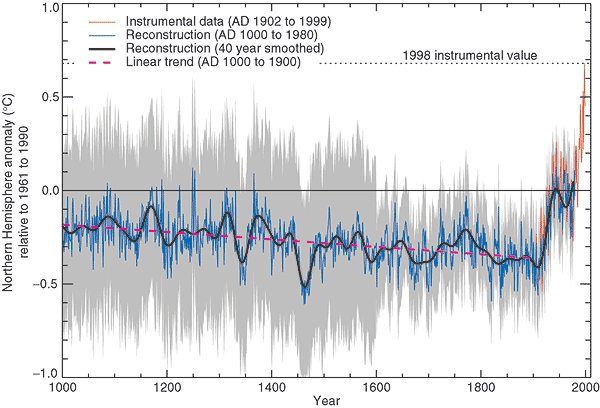 The “hockey stick” graph as published in IPCC TAR (Figure 2-20, 2001) By Jo Nova
Climate deniers must be punished
For newcomers: Michael Mann’s hockeystick graph was wildly different from hundreds of studies of other studies and instantly became the pet graph of the IPCC. It used the wrong proxy, the wrong tree, and the wrong type of averaging. Whole books were written on how bad it was. But when Mark Steyn called it fraudulent Mann sued.
Twelve long years after the case was launched, the six person jury decided that Mark Steyn and Rand Simberg have defamed Michael Mann, but awarded Mann one whole dollar in damages, because he hadn’t been able to prove he suffered any damage at all. Remarkably, though, the jurors felt the skeptics had been so malicious they added punitive damages too. Usually these are limited to a mere four or five times the compensatory damage, but this time it was decided Simberg should pay $1,000 and Mark Steyn $1 million. It sets a new record.
According to Law.com punitive or exemplary damages are saved for truly dreadful acts:
exemplary damages n. often called punitive damages… are damages requested and/or awarded in a lawsuit when the defendant’s willful acts were malicious, violent, oppressive, fraudulent, wanton or grossly reckless. These damages are awarded both as a punishment and to set a public example.
So the jury agrees that Mark Steyn did no material harm to Mann but criticizing climate scientists is itself an unforgivably evil thing.
The point is to silence you
The lawyer for Michael Mann had pushed for these punitive damages in his closing arguments (since there weren’t any real damages). John Hinderaker reported that Mann’s lawyer specifically asked the jury to deter “climate deniers” who were apparently as dangerous as “Trump election deniers”. And to a Washington D.C. jury, somehow that made sense. It took thirty years of televised propaganda to create this payday. Cheap namecalling on the news makes for a whole city of hate, ready to pass judgement.
The jury probably couldn’t even imagine how anyone could believe a climate expert might be wrong.
John Hinderaker points out there’s no evidence there was any malice involved:
In a sane world, this case never would have gone to the jury. The legal standard is actual malice, which means the defendants must have thought, subjectively, that what they said wasn’t likely true. In this case, there was no evidence whatever that Steyn and Simberg didn’t sincerely believe that what they said was true. Indeed, as Mark pointed out in closing argument, he has been saying the same things about Mann’s hockey stick for something like 21 years, and even wrote a book about it (pictured to the right).
As Mark Steyn so calmly explained at SteynOnline, he will take this all the way to the Supreme Court if he has to:
The latter number will likely get overturned at the United States Supreme Court, which generally reckons that “in practice, few awards exceeding a single-digit ratio between punitive and compensatory damages, to a significant degree, will satisfy due process” – and that’s when “the defamatory statements do not involve matters of public concern”. A “single-digit ratio” means four-to-one, five-to-one punitive-to-compensatory. Steyn’s jurors just set a record – a million-to-one ratio.
So, under the Supreme Court guidelines, the punitive damages of $1,000,000 could in theory be reduced to, er, four dollars. Mark may likewise be reduced, somewhat mortifyingly, to waving that US constitution around. Whether his health will hold out long enough to get him before Chief Justice John Roberts and the rest of the gang is a different question.
But as Mark has said in the past, the process is the punishment, and so this punishment will go on.
As Hinderaker explains, with these extraordinary punitive damages, Mann’s lawyer has succeeded in turning a defamation case into a free speech one. The whole point of the damages is to deter people speaking their minds freely:
… now Michael Mann’s lawyer has made it explicit: impose an arbitrary seven figure penalty on Mark Steyn, not to compensate the plaintiff Michael Mann, who didn’t suffer any damages whatsoever, but rather to deter anyone from ever again arguing that climate change alarmists are wrong, however flawed their science may be.
It is hard to imagine anything more anti-scientific or anti-American.
Mark Steyn is a member of the media. As such he is supposedly afforded First Amendment protections. If a member of the media is no longer protected, what do you think that means for every day citizens? And it doesn’t matter if you are in DC or Montana — anyone can file in the jurisdiction of his or her choosing.
She quotes Justice Alito who accurately forecast how defamation suits in the right city could be used to silence dissent across the whole country on complex topics like climate change:
…the controversial nature of the whole subject of climate change exacerbates the risk that the jurors’ determination will be colored by their preconceptions on the matter. When allegedly defamatory speech concerns a political or social issue that arouses intense feelings, selecting an impartial jury presents special difficulties. And when, as is often the case, allegedly defamatory speech is disseminated nationally, a plaintiff may be able to bring suit in whichever jurisdiction seems likely to have the highest percentage of jurors who are sympathetic to the plaintiff ‘s point of view…
If citizens cannot speak freely and without fear about the most important issues of the day, real self government is not possible. To ensure that our democracy is preserved and is permitted to flourish, this Court must closely scrutinize any restrictions on the statements that can be made on important public policy issues. Otherwise, such restrictions can easily be used to silence the expression of unpopular views…
The sacred graph must be protected from critics
The HockeyStick graph underpins a trillion dollar industry. If the weather was just as warm in the medieval period then CO2 is not the control knob on Earth’s temperature dial and the models are missing some big natural drivers.
Even after all these years, the HockeyStick graph still forms a core part of the IPCC’s case, even though no one seems to be able to find any tree rings from the last 50 years so they can update it. We have no trouble finding 800 year old trees, but for some reason we can’t find ones alive today to tell us the temperature in 2023.
If only the planet still had trees, Mike wouldn’t need to use his Nature Trick to hide the decline.
In the immortal words of Professor Phil Jones himself:
“I’ve just completed Mike’s Nature trick of adding in the real temps to each series for the last 20 years (ie from 1981 onwards) and from 1961 for Keith’s to hide the decline.”
Judith Curry has written an extraordinary exposition of the whole sorry saga of the Hockeystick, with all its gory details. Unfortunately, ain’t it the way, it was not admitted in court as evidence. It’s all at her blog. Savage.
Readers, be aware the word fraud is moderated here, so best to use other terms – like misleading, inept, incompetent, and a travesty of science. There are plenty to pick from.
Heartland are hosting: Mann vs. Steyn: A Disgrace to the Profession – Climate Change Roundtable #97
_________________
h/t to RickWill, David Wojick, Bill in AZ, El Gordo, Willie Soon, Joe Bastardi
9.8 out of 10 based on 138 ratings
9.9 out of 10 based on 14 ratings
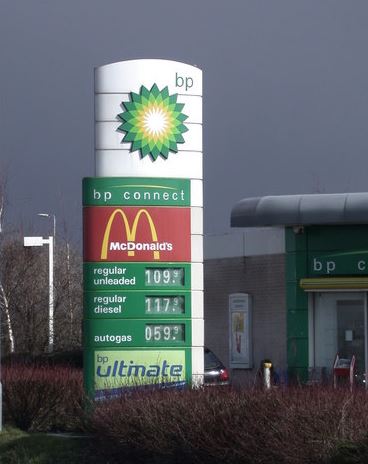 By Jo Nova By Jo Nova
There’s no hiding that this is a major backflip
History books will be written about corporate mistakes.
Twenty years ago BP called itself “Beyond Petroleum” and by 2020 the company was hellbent on getting there. They pledged to reduce their own oil production by 40% by 2030, and promised to pivot into renewable power. The media was thrilled — “BP Shuns Fossil Fuels“, said Politico, and shines a light on “stranded oil and gas”. Only two years ago BP talked of “accelerating” it’s green investments. Then the price of oil and gas exploded and problems with unreliable energy started breeding.
Now BP is writing off a billion dollars in offshore wind investment, and the new CEO is calling for “pragmatism”. The company has flipped from cutting oil production 40% by 2030 to increasing it instead.
The new chief, Murray Achincloss said they still want to be “an integrated energy company” (presumably so it looks less like a full-reverse and more like a “tweak”), but he betrayed himself when he said: “we see growing demand for energy right now across the globe”. “It is not slowing down.” When he says energy, he means oil and gas.
By Stanley Reed, New York Times
BP has a plan to become what Mr. Auchincloss called an integrated energy company. But in the meantime, “we see growing demand for energy right now across the globe,” he said. “It is not slowing down.”
He just wants to make oil and gas cheaper for us, really…
BP is “going to invest in today’s energy system, to help make sure that prices don’t get out of control,” Mr. Auchincloss said. “So that’s investing into oil and gas,” he added, while also putting money into alternative energy sources like biofuels and hydrogen.
But all those promises to cut oil production by 40% are gone with the wind:
…the company’s mainstay oil and gas production rose 2.6 percent last year. Supplies of liquefied natural gas — a chilled, compressed fuel transported by ships — rose by more than 20 percent.
Mr. Auchincloss said that oil output would continue to rise 2 percent to 3 percent a year through 2027 because of production increases in Abu Dhabi, Angola, the United States and elsewhere.
Chasing green rainbows has been an expensive mistake:
By Benjamin Storrow, E&E News
Call it a $1 billion mistake.
BP said Tuesday it wrote down the value of its U.S. offshore wind business by $1.1 billion last year, cementing a strategic shift for the British petroleum giant as it increases oil and gas production while recalibrating its efforts to generate clean electricity from ocean turbines.
It’s partnership with Equinor, meanwhile, increasingly looked like an albatross, with one company executive calling the U.S. offshore wind market “fundamentally broken.
BP’s shares have flatlined, while Exxons have grown 40%
Auchincloss can no doubt be only too aware of BP’s lagging share price relative to its rivals in recent years, which many blame on the company’s green agenda. BP’s shares are trading broadly in line with pre-pandemic levels, but by contrast ExxonMobil’s share price has surged by about 40% over the period. – – BP’s green agenda all at sea, Jillian Ambrose, The Guardian.
Finally shareholders demand profits and sensible plans
One shareholder of BP turned activist last October and wrote an extraordinary letter to the company to pressure it to drop the “irrational” net zero target and even to sack a board member with links to BlackRock.
Bluebell Capital is a hedge fund in London and it had some remarkable requests:
Matt Oliver, The Telegraph
In a 30-page letter, Bluebell called on BP to scrap its commitment to scale back its oil and gas business by a quarter this decade, halt investment in renewable energy schemes and rewrite its net zero targets to clarify they will be achieved “in line with society”.
Bluebell argued that the targets will artificially constrain BP and leave it at a disadvantage compared to rivals such as Shell and ExxonMobil…
The activist is also demanding that BP returns an extra $16bn (£12.6bn) to shareholders this decade, and urged the oil giant to sack a board director with links to fund giant Blackrock, which it branded “a world champion of ESG inconsistency and hypocrisy”.
As Bluebell so aptly remarked:
“And in the short term, don’t cut your own production, because you are just doing a favour to the other [oil] companies.”
Bluebell Capital appear to have invested in BP because it was “undervalued” and were betting on a plan that the company could be turned around. They argued that BP would have been worth 50% more on the sharemarket but for this “ill conceived strategy” and scathingly pointed out that BP should keep out of renewable projects where it has little specialist expertise.
In the long run the CEO doesn’t see windmills, he see gas and more gas
It’s surely no coincidence that the new CEO made this statement just a month ago:
Johnathon Leake, The Telegraph
Boom in tools such as ChatGPT means data centres require more power
Mr Auchincloss said: “Gas production will probably go a little bit lower this decade and then will grow significantly as we move into the following decades… Generative AI is something that’s creating an even higher level of demand for electricity.”
The amount of energy consumed by the 8,000 data centres globally is predicted to soar by 73pc to 800 terawatt hours (TWh) by 2026, according to the International Energy Agency.
By comparison, the UK consumes 321 terawatt hours of electricity a year.
According to research by data experts Digiconomist, in order to move its entire search engine operations to AI, Google would need as much electricity to power a country the size of Ireland.
Right now BP is acting as though it has swung right back to being an oil company, but it’s still saying the recent set backs are just a delay. But any company doing a complete reversal would say that, wouldn’t they?
A year ago we saw a dramatic shift in language across the company –– talking about their disappointment with renewables, and their shift back to oil and gas. So they were already starting the backflip then, perhaps the Bluebell plan was to wait for the right moment to tighten the screws?
Photo by Keith Edkins |
10 out of 10 based on 103 ratings
9.5 out of 10 based on 11 ratings

Image by GrumpyBeere
By Jo Nova
Last year the acceleration in EV sales stopped accelerating. The industry was still growing they said, just not quite as fast. Now, so soon, the sales are actually falling. In the UK, EV sales dropped off a cliff, falling 25% last month. Perhaps it was just a bad month? But in California, home of global green dreams, sales have also declined, and for the last two quarters. Ominously, this is happening despite government decrees insisting every new car sold in 2035 will be an EV. Sales are supposed to be launching into orbit. Something is very wrong.
Meanwhile Hertz has taken yet another step away from their EV quest — after announcing they were selling off a third of their EV fleet at bargain basement prices, now they are cancelling plans to buy 65,000 Polestars. This was a $3 billion deal, and to let them out of it, Polestar has, by golly, demanded Hertz give them the right to buy back the old Polestars that Hertz wants to sell — that way Polestar can keep the older models off the secondhard market and stop the value from falling the same dire way the secondhand Teslas have.
Polestar is a Volvo spin off company, and now we understand why last week Volvo announced it would stop funding Polestar and reduce its shareholding. They knew what was coming.
Not to put too fine a point on the state of the EV market, but Ford is losing $38,000 per EV. This means the more EVs they sell, the poorer the company gets. They made $10 billion dollars in profits last year, yet the balance sheet shows they lost about $5 billion just on EVs. This puts them in the bizarre position that they could theoretically give away the entire EV production line and boost company profits by 50%. It’s that bad…
Indeed it’s so truly awful, that the UK Lords are calling for the government to counter the misinformation campaign filled with “mistruths”. The industry must be at deaths door.
Robert Lea. The Times
Britons appear to be turning their backs on new electric cars, with the number of zero-emission vehicles sold to private buyers falling by 25 per cent last month.
The latest figures from the Society of Motor Manufacturers and Traders (SMMT) prompted the industry body to cut forecasts on the proportion of the total market that will go electric this year.

Agent 009, Autospies
Despite a sustained and seemingly unstoppable growth, the registration of battery-electric vehicles in California experienced a downturn in the last quarter of the previous year. Notably, EV sales have consecutively declined for two quarters, even as California authorities set a 2035 deadline for all new vehicle registrations to be zero-emission.
California recorded 89,993 registrations for electric light passenger vehicles in the fourth quarter, marking a 10 percent decrease from the 101,151 recorded in the third quarter.
What’s a free market for anyway? Perhaps to save Ford shareholders $5,000 million dollars?
By Stephen Wilmot, The Wall Street Journal
Ford’s “Pro” business, which comprises its sales to companies, is the engine behind Ford’s results. It made $7.2 billion of operating profit last year, and the company expects that to rise to at least $8 billion in 2024. The supersize Super Duty, which is mainly a professional product, is a key reason. It is also easier to sell software to businesses than consumers, who can get a lot for free.
Meanwhile, electric vehicles lost $4.7 billion last year, and the company sees the losses deepening to between $5 billion and $5.5 billion this year. To put this another way, if Ford weren’t selling its Mustang Mach-E and F-150 Lightning models and investing in a new generation of products to replace them, its adjusted operating profit would be 50% higher.
When all else fails, and there’s no way to answer the critics, silence them instead
Baroness Parminter, chair of the committee, told the BBC that both government officials and other witnesses to the enquiry had reported reading disinformation on the subject in national newspapers.
“We have seen a concerted effort to scare people… we have seen articles saying that cars are catching fire – but had evidence that the fire risk is absolutely the same as [petrol and diesel] cars,” she said.
Richard Bruce, Director of Transport Decarbonisation at the Department for Transport, conceded there was a problem…”There is an anti-EV story in the papers almost every day. Sometimes there are many stories, almost all of which are based on misconceptions and mistruths, unfortunately.”
The bottom line: don’t let them speak, but make them give us more money:
As well as tackling misinformation the committee also called on the government to unlock funding more quickly for local authorities to install charging infrastructure.
And just at this moment Australia is about to bring in rules to force Australians to buy EVs so we can save the World, or make some international bankers rich, whichever comes first.
Telsa image by ben saida from Pixabay
9.8 out of 10 based on 124 ratings
9.5 out of 10 based on 12 ratings

By Jo Nova
Farmers win the day after mass protests
Thousands of farmers in tractors and trucks protested in the Netherlands, Germany, France, Ireland, Sweden, Portugul, Greece and Spain. Farmers in Poland are planning to block the Ukrainian border. The French farmers held Paris under siege, blocking roads, pouring manure everywhere and leaving supermarket shelves empty, then after they won some concessions from President Macron, they kept on driving to Brussels and did it all again with help from farmers from other countries. The EU is the target.
The thing that made this so potent was not just that the farmers had heavy equipment that moved obstacles and drove over barriers, they also had huge public support. Something like 80 to 90% of French citizens supported the farmers and were willing to put up with the inconvenience. Then to cap it off, EU elections are coming in June, and they only happen once every five years. The Greens look like they will do badly. That people like Geert Wilders can win in national elections must have shocked the politerati class. But right wing governments have been elected in Italy, Sweden, and Finland too.
This looks like a major win. Not only is the EU backing down on the demands to cut nitrogen and methane by a third, but they’re also not going to halve the use of pesticides, and they’re not even going to harass EU citizens smugly telling them to eat less meat.
The next big move of climate activists was through agriculture, but this has, for the moment, hit the fan…
The Telegraph
The European Union has caved in to angry protests from farmers and cut a target to slash agricultural emissions as part of the bloc’s net zero drive.
A demand to reduce nitrogen, methane and other emissions linked to farming by almost a third has been removed from a wider Brussels plan to cut greenhouse gas emissions by 90 per cent by 2040.
The move to offer concessions to the farmers would be seen as a major step away from the bloc’s original green plans.
People may have missed just how big the European farmer protests have been. For some reason the media didn’t want to cover what happens when farmers get angry. Like the truck-driver protests in Canada last year, these sort of revolts are potentially dangerous to the political class. They can bring a nation to its knees in days. Journalists and media moguls scorn the workers, but they quietly fear their power. If the masses wake up and realize they don’t have to put up with rules set by chattering classes and desk jocks, that could wreck the cushy lifestyles of the wordsmiths and academics.
A truckload of manure can stop the traffic…

Such was the anger, there were fires in the carpark of the EU Parliament, and fires on French highways.

…
Reuters: At least 14 highways in the regions of Catalonia, Andalusia, Castille-La Mancha and Valencia were blockaded, official traffic data showed.
Victor Orban PM of Hungary explains that the EU rules destroy farming in Europe by imposing rules on European farmers but then allowing produce from other parts of the world to come in which have none of these rules. The push to reduce pesticides and force organic farming onto European farms, but not on imports was one of the major complaints about EU regulations.
Nigel Farage explains the importance a week ago:
The war is far from over. After the elections, if there is any way they can, the EU still wants to bring in absurd laws of climate voodoo and witchcraft.
[Reuters] The European Commission is set to recommend an ambitious goal to cut net greenhouse gas emissions by 90% by 2040. The target would aim to foster green jobs and low-carbon industries, drafts of the proposal showed.
Polls show more seats could go to far-right and right-leaning parties opposed to climate policies. EU officials say backing for ambitious green laws has also been eroded among EU states by recent elections in Finland, Sweden, the Netherlands and Luxembourg.
Photos came from these Twitter links:
Thank you Elon.
Apologies to readers, these Twitter videos take a long time to load.
9.9 out of 10 based on 94 ratings
10 out of 10 based on 8 ratings

By Jo Nova
A team of psychologists were so sure “climate deniers” deceive themselves for selfish reasons that they ran three experiments with four thousand people, only to find they were completely wrong.
The researchers figured that those who do not accept that coal makes storms and floods must be motivated by their desire to keep on polluting, or flying, or feeling warm, and so they lie to themselves about the science in order to feel OK about it. (A bit like academics must do when it turns out they get paid well, but don’t know their research topic at all, maybe?)
It must have been quite the shock when Zimmermann and Stötzer were proved wrong on every single experiment. They even tried to bribe skeptics with $20 cash rewards and it still wasn’t enough.
Do climate change deniers bend the facts to avoid having to modify their environmentally harmful behavior? Researchers from the University of Bonn and the Institute of Labor Economics (IZA) ran an online experiment involving 4,000 US adults, and found no evidence to support this idea. The authors of the study were themselves surprised by the results.
One hypothesis is that these misconceptions are rooted in a specific form of self-deception, namely that people simply find it easier to live with their own climate failings if they do not believe that things will actually get all that bad. “We call this thought process ‘motivated reasoning,’…
The only thing the study showed was the dire state of psychological science. For starters, researchers were oblivious to their own prejudice and incompetent background research. They can’t define a climate change denier in any scientific sense, it’s not a label of a group of homo-sapiens who think the climate never changes, it’s just a petty kindergarten insult designed to fool, well… psychologists. And it works. If they had spent five minutes reading skeptical web-sites they’d know that half the population have good reason to be skeptical of unaudited and unaccountable foreign committees which rely on broken models. In fact if they were looking for “motivated reasoning” in the climate debate (and they say they were) then most of it is on the believer side, where people might be motivated by billions of dollars in government grants.
Zimmermann and his colleague Lasse Stötzer told people they could decide where a $20 donation went — they could choose which climate charity would get the cash, or they could keep it themselves. The “control” group weren’t allowed to keep the cash themselves. Basically 41% to 44% of the crowd kept the money. But amazingly more than 50% still gave the cash to a climate charity. Humans are nice people, really. I mean, they could all have kept the cash, and most didn’t. Presumably no one wants to look too scroogey in front of researchers, but some people know climate charities are pagan groups designed to cheat money from the poor and give it to billionaires — so it’s better to look like a scrooge than feed the machine.
At the center of the experiments was a donation worth $20. Participants were allocated at random to one of two groups. The members of the first group were able to split the $20 between two organizations, both of which were committed to combating climate change. By contrast, those in the second group could decide to keep the $20 for themselves instead of giving it away and would then actually receive the money at the end. “Anyone keeping hold of the donation needs to justify it to themselves,” says Zimmermann, … “One way to do that is to deny the existence of climate change.”
In another variation, participants could pick either a skeptical video or a believer one, and the researchers hoped somehow it would show people who kept the money would choose the skeptical video to reassure themselves that they were right. But as it happens, about 51% of the control group wanted to see “the skeptical side” of this 30 year long boring debate, which was slightly more than the test group. Foiled. Another null result.
It was good, bad, nothing-news really — another piece of useless academic study, and the experts don’t know how to convince anyone:
This finding was also borne out in two further experiments. “In other words, our study didn’t give us any indications that the widespread misconceptions regarding climate change are due to this kind of self-deception,” says Zimmermann, summing up his work. On the face of it, this is good news for policymakers, because the results could mean that it is indeed possible to correct climate change misconceptions, simply by providing comprehensive information. If people are bending reality, by contrast, then this approach is very much a non-starter.
All five treatments found nothing, even though there was money to be had. They even sliced and diced the data according to income to see if poorer people were more likely to keep the money and then “become” a skeptic, but they couldn’t even find a link there.
We do not observe that more financially constrained participants choose the selfish action more frequently in reaction to our treatment variation.
Contrary to our hypotheses, we find no evidence that motivated cognition can help to explain widespread climate change denial and environmentally harmful behaviour.
It never even occurred to Zimmermann and Stötzer that their life’s work was to figure out how to force an absurd political fantasy on to half the population. Do windmills today stop storms in 2100AD? Will solar panels stop the oceans rising? Is it possible that one trace gas controls the global temperature when water vapor is far more important, 10 to 100 times as abundant, and subject to rapid change on a minute by minute basis? Is it possible that the sun and space weather has an effect on our climate through the solar wind, the magnetic field, the heliospheric plane, cosmic rays, or spectral changes.
And lastly, just in case these 2,000 people (or 0.0001% of US voters) were influenced by watching one skeptical video the researchers had to “debrief” them.
To mitigate the ethical concern about showing some participants a video casting scepticism about climate change by presenting factually wrong information, we added a short debriefing for all participants at the end of the experiment (Supplementary Information).
You know it’s a cult…
h/t Willie
Reference:
Lasse S. Stoetzer, and Florian Zimmermann, (2024) “A representative survey experiment of motivated climate change denial” by 2 February 2024, Nature Climate Change. DOI: 10.1038/s41558-023-01910-2
Image by Mystic Art Design from Pixabay
9.8 out of 10 based on 79 ratings
9.3 out of 10 based on 16 ratings
9.2 out of 10 based on 14 ratings
8.1 out of 10 based on 24 ratings
|
JoNova A science presenter, writer, speaker & former TV host; author of The Skeptic's Handbook (over 200,000 copies distributed & available in 15 languages).

Jo appreciates your support to help her keep doing what she does. This blog is funded by donations. Thanks!


 Follow Jo's Tweets
Follow Jo's Tweets To report "lost" comments or defamatory and offensive remarks, email the moderators at: support.jonova AT proton.me
Statistics
The nerds have the numbers on precious metals investments on the ASX
|

































Recent Comments